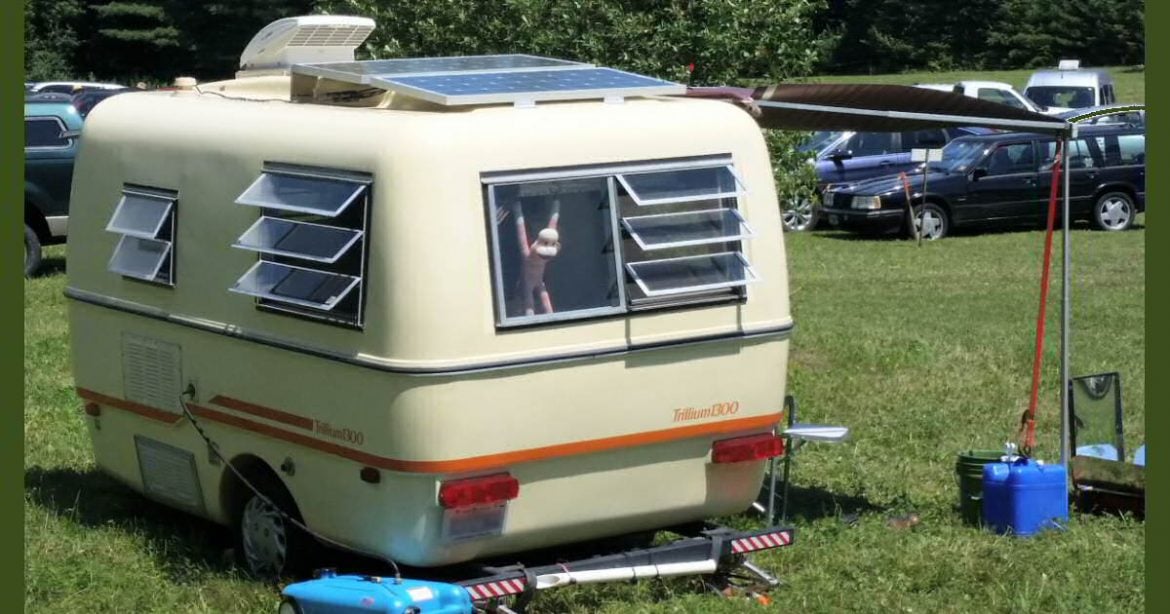
On the Road Again
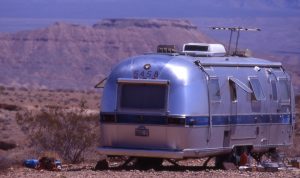
Solar panels for RVs provide you with freedom plus peace and quiet.
Summer is here, and it’s time to dust off that RV and start planning your next road trip! Perhaps you were wondering if solar panels for RV use would make sense. If that trip includes the road less traveled, you may not have access to electricity when you park your home away from home. While you are driving, you can have the alternator charging up your house batteries.
However, once you found that perfect spot, you aren’t going to be turning on the engine to charge up. While enjoying the peace and quiet of the great outdoors, the last thing you want to hear is a generator. Adding solar panels to your RV may be the answer you’ve been looking for. In this blog we’ll show you how to size a solar power system for your RV or camper.
We Need More Power Scotty
When making your own power for your off-grid your RV, the first step is to figure out how much power you need to make. You do this by creating a loads list. How much power does each device use, and for how long. This step can be a bit tedious… ok, a lot tedious, but it is crucial for determining if you can go off grid with your current loads. You may find that you need to reduce your loads or increase your ability to make power.
Look for the Label
Any UL Listed electrical device will have a label on it saying either how many watts it draws, or volts and amps, which can be multiplied together to get watts (volts x amps = watts). When you know the watts (W), you multiply it by the number of hours running, to get watt hours (Wh). For example, a 100W load running for 2 hours uses 200Wh. If your load runs for minutes instead of hours, multiple the watts by 0.016 per minute. (1 hour ÷ 60 minutes = 0.016 hour).

The ETL & UL labels will tell you how many watts an appliances consumes.
Table of Common RV Appliances and the Power They Use
Below is a list of common items you may be trying to power with the amount of watts they use and then how many watt hours they consume for various amounts of time running. Keep in mind that there can be a wide range of power requirements, so yours may be different.
Note that as energy efficient appliances are becoming more common, these numbers may be high. It is best to check the actual output of your devices for an accurate loads list.
| Appliance
* Requires/prefers pure sinewave inverter |
Typical Wattage | 5 min
(.08 hour) |
30 min
(.5 hour) |
1 hr | 2 hr | 4 hr | 8 hr | 24 hr |
| 120V AC Appliances | ||||||||
| 18.5” color LED TV | 18W | 1.44Wh | 9Wh | 18Wh | 36Wh | 72Wh | 144Wh | 432Wh |
| Fan | 40W | 3.2Wh | 20Wh | 40Wh | 80Wh | 160Wh | 320Wh | 960Wh |
| LED light* | 10W | .8Wh | 5Wh | 10Wh | 20Wh | 40Wh | 80Wh | 240Wh |
| Blender (invite us over if you’re running the blender more than 2 hours!) | 350W | 28Wh | 175Wh | 350Wh | 700Wh | |||
| Toaster | 900W | 72Wh | 450Wh | |||||
| Coffee Maker | 850W | 68Wh | 425Wh | 850Wh | ||||
| K-cup machine* | 1500W | 120Wh | 750Wh | 1500Wh | ||||
| Waffle Maker | 650W | 52Wh | 325Wh | 650Wh | ||||
| Compact Microwave | 1000W | 80Wh | 500Wh | 1000Wh | ||||
| Phone charger* | 8W | .64Wh | 4Wh | 8Wh | 16Wh | — | — | — |
| Laptop* | 40W/10W | 3.2Wh | ||||||
| Tablet* | 10W | .8Wh | 5Wh | 10Wh | 20Wh | 40Wh | — | — |
| Hair dryer | 1500W | 120Wh | 750Wh | |||||
| ⅜” drill* | 440W | 35Wh | 220Wh | 440Wh | 880Wh | 1760Wh | ||
| Fridge (AC Mode)* (Due to power use, best to run in LP mode when off grid) (Calculations are assuming compressor running half of time) |
700W | 28Wh | 175Wh | 350Wh | 700Wh | 1400Wh | 2800Wh | 8400Wh |
| Vacuum* | 500 | 40Wh | 250Wh | |||||
| RV AC (1500BTU)* | 3500W / 1500W | 120Wh | 750Wh | 1500Wh | 3000Wh | 6000Wh | 12kWh | 36kWh |
| 12V DC Appliances | ||||||||
| CO Detector | 1W | — | — | — | — | — | — | 24Wh |
| Propane Alarm | 1W | — | — | — | — | — | — | 24Wh |
| Furnace | 100W | 8Wh | 50Wh | 100Wh | 200Wh | 400Wh | 800Wh | 2400Wh |
| Fridge (LP Mode) | 10W | .8Wh | 5Wh | 10Wh | 20Wh | 40Wh | 80Wh | 240Wh |
| Water pump | 48W | 4Wh | 24Wh | 48Wh | 96Wh | |||
| Lights | 10W | .8Wh | 5Wh | 10Wh | 20Wh | 40Wh | 80Wh | 240Wh |
| Radio | 10W | .8Wh | 5Wh | 10Wh | 20Wh | 40Wh | 80Wh | 240Wh |
Building Your Loads List
An even better method can be to plug any AC device into a power meter such as a Kill A Watt meter to get an accurate reading over time. You can watch a video we did on the Kill A Watt meter way back in 2007:
The next step is to add it all up in a loads list to see how much power you need in total. Creating a loads list lets you accurately see how many watt hours total you need to make and store. You can write it up in a table or go to our handy Loads List Calculator. Watch our video stepping you through the calculator for help.
We’re going to walk you through designing a solar system for an RV with some fairly small loads. After all, we’re getting away from it all, so we’re going to keep our electricity needs to a minimum. Air conditioning can be a necessity in your RV in some areas. Often the best solution is to have a generator to provide the power for it, or only use it when you are at a campground with shore power available. An off grid solar system that will provide enough power for such a high load, and still fit on your RV, may not be possible or practical.
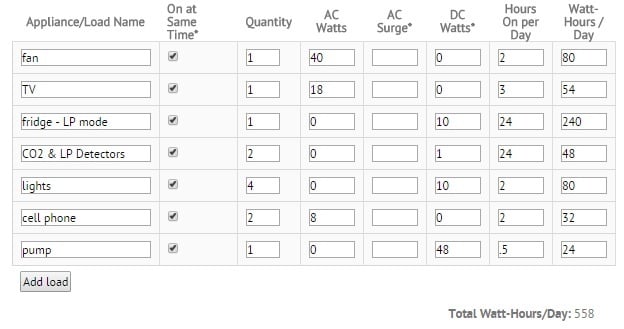
Creating a Loads List
Sizing your RV Solar System
We’ve got great news for you – the hardest part of the project is over. Now that you have your loads list done, and you know how many watt hours of power you need to make, you can go to our Off-grid calculator to figure out what size battery bank and solar panel(s) you need. If you want some help with the calculator, you can check out our video walking you through it here.
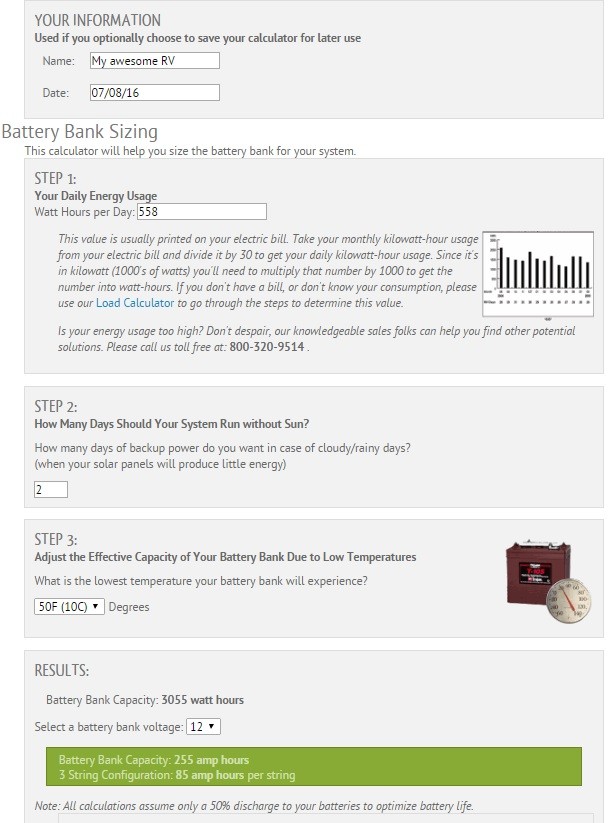
altE Store off grid calculator – page 1
If you do have 12VDC loads that you plan on running directly off your battery bank, you may want to stick with a 12V battery bank. If you have a large system that requires higher than a 12V bank, a DC/DC converter can convert the higher voltage battery bank (e.g. 24V or 48V) for your 12V needs. For more details on batteries, go to our blog Understanding Deep Cycle Batteries.
Deep Cycle Battery Bank
The results of the calculator tell us we need 255Ah of batteries for a 12V battery bank. We’re going to choose sealed batteries for our system for simplicity; no need to add water, no risk of spilled acid or gasses that we may have to deal with with flooded batteries. Looking through our selection, we have several options, depending on the size of the space we have available to install the battery.
We can choose multiple 12V small amp hour batteries that we can wire in parallel (with pluses together and minuses together to increase the amp hour but keep the volts at 12V). So, for example, we could choose three of the MK8A27 12V 92Ah, for a total of 276Ah 12V, giving us a little extra storage. Or we can choose multiple lower voltage batteries, and wire them in series, plus to minus, to create 12V, like the Concorde SunXtender PVX-3050T 6V 305Ah, for 12V 305Ah, giving us even more wiggle room. Or, if you have a friend with a strong back who could help carry a single it, you could select a 12V 245Ah MK Battery 8A8D. It’s 10Ah smaller than our calculations, but we can turn off the light a little earlier at night to adjust our loads as needed.
How Much Solar Do You Need?
Now let’s go back to the second half of the Off Grid Calculator to see how many solar panels for the RV we need. To do that, we need to know how much sun is available in our area. Since our example RV is seasonal, we don’t have to figure out sun for winter, just the seasons we’re RVing.
There’s a handy table to look at best, worst, and average sun hours of major USA cities. For a three season system, you can use the average number. Below is a partial list, see the complete table here.

USA Solar Insulation – partial list
We’ll use Lincoln, Nebraska for our example. That’s 4.79 sun hours.
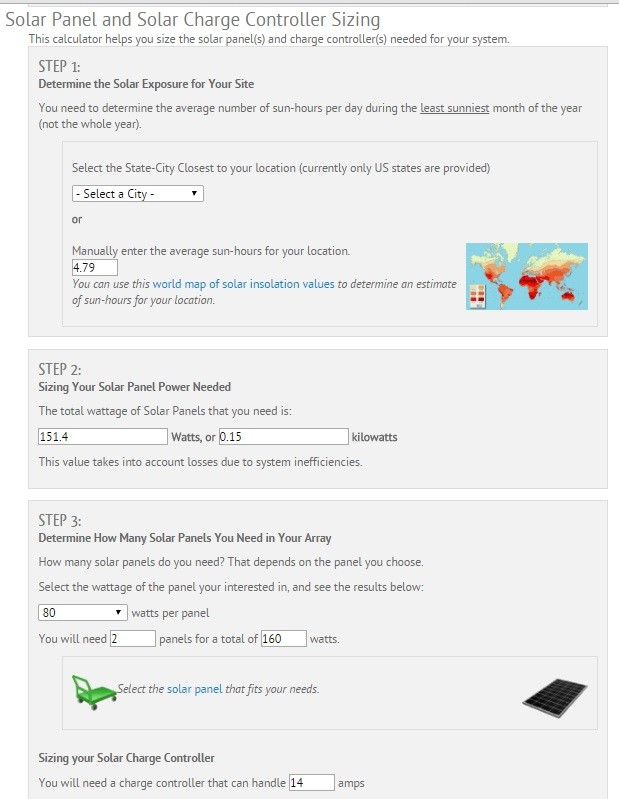
altE Store off grid calculator- page 2
We put 4.79 sun hours into the 2nd half of the off grid calculator, and are told to make enough power for our 558Wh loads, we need at least 151 watts of solar. If you are permanently mounting the solar panel for RV use, you need to check out how much space you have available on your vehicle. There may be obstacles such as vents, antenna, AC unit, etc already up there. The best option for you may be multiple small panels that can fit around the other items already up there.
Solar Panels for RV Options

They Kyocera Solar 12 volt 150 watt solar panel is well suited for RV use.
So we’ll take a look at options available for solar panels, and again we have a number of options. Kyocera makes a beautiful 150W 12V solar panel, the KD150GX. Keep in mind that we will be mounted flat on the roof, and possibly under less than perfect conditions. Therefore, it may make sense to oversize the solar array a little to give us more leeway. We could select two of the altE 80W 12V solar panels and wire them in parallel, pluses together and minuses together, to add up to 160 watts 12V.
These panels can easily be attached to the roof of the PV with mounting feet. There are some mounts that are available that will allow you to tilt a small panel, but it might be more effort than it’s worth to climb up onto the roof and set the angle each time you park. Especially since most RVs won’t be used in snowy season, where snow would accumulate on flat panels, and the low winter sun would be more off angle than with the high summer sun.
RV Solar Charge Controller
The charge controller has a few different tasks, but the primary job is to manage charging the battery bank from the solar panel array. The charge controller is the traffic cop, letting the right amount of power go into the battery, and making sure power doesn’t go out of the battery to the solar panel at night.
There are two main types of solar charge controllers, PWM and MPPT. The biggest, and for this topic, the most important difference between the two is that a PWM charge controller has to use the same voltage solar array as battery bank (i.e. 12V solar panels and 12V battery bank), whereas an MPPT charge controller can have a different voltage solar panel than the battery bank, i.e. a 20V or 24V solar panel and a 12V battery bank.
We’ve got lots of videos that talk about charge controllers, so for the sake of time, we’re going to just talk about picking the right size charge controller for your RV. Selecting the right size charge controller is slightly different for PWM and MPPT charge controllers.
Sizing a PWM Solar charge controller
To select the right size PWM charge controller, you need to know the short circuit current, or “Isc”, of the solar panels you are using. You can find it on a label on the solar panel, or on the datasheet. For our example here, we are using two of the altE 80W panels in parallel.
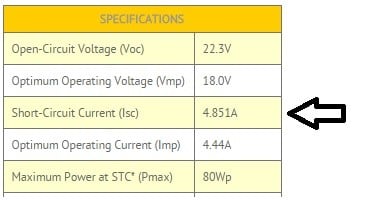
Standard Test Conditions (STC) for alt80 solar panel
We take the solar panel’s Isc and stick it into the following equation:
Minimum Amps PWM Charge Controller = Isc x # in parallel x 1.25 safety margin = 4.851 amps x 2 in parallel x 1.25 safety = 12.12 amp PWM charge controller needed at minimum
A PWM charge controller that is very popular with RV’ers is the Morningstar SunSaver Duo. The Duo can handle up to 20 amps Isc from the solar array, so it does give you room for expansion if you add more panels in the future. A cool thing about the Duo, designed with RV user in mind, is that it has the ability to charge both your house battery bank as well as the starter battery from the same solar array. It also comes with a handy display panel for you to mount on the wall to monitor the status of your batteries. You can watch a demo of it here.
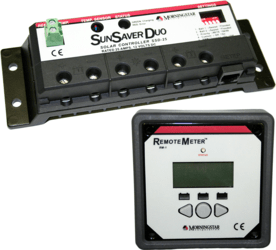
Morningstar SunSaver Duo with meter was designed for RV use.
Sizing an MPPT Solar Charge Controller
Selecting the right size MPPT charge controller is actually quite simple. Take the wattage of the solar panels and the voltage of the battery bank, and use the following equation.
Minimum Amps MPPT Charge Controller = Solar Panel Watts x # solar panels ÷ battery bank voltage
= 80 watts x 2 panels ÷ 12V battery bank
= 13.3 amp MPPT charge controller minimum
A nice example for a small MPPT charge controller made for RV use is the Blue Sky Solar Boost 1524iX. It also has the added feature of providing a 2 amp auxiliary charge to a second battery, such as the starting battery.
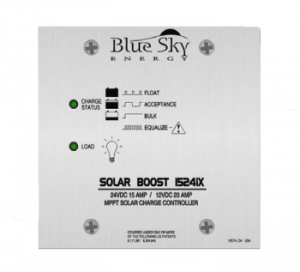
Blue Sky SolarBoost 1524iX solar charge controller is designed for RV use.
DC/AC Inverter for RV Use
OK, we are almost there. Actually, if you don’t have any AC appliances you are plugging in, and you are only charging the battery bank from solar, you’re done! But, if you do need to convert the DC from the batteries into AC for your appliances, you need an inverter. You also need a charger if you plan to charge your battery bank with AC power. This can be done when you are at a campground and have shore power available, or with a generator. Fortunately, you can get one piece of equipment to do both, an inverter/charger.
Please Note: Don’t confuse this charger with the solar charge controller. The inverter/charger uses AC power to charge your battery bank. A solar charge controller uses the DC power from the solar panels.
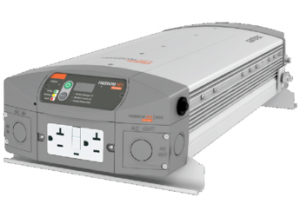
Xantrex Freedom HFS Inverter/charger
Not All Mobile Inverters are Built Equally
The AC output from an inverter can either be modified or pure sinewave. For a greater look into the difference between the types of waves, read our blog, Pure Sine Wave vs. Modified Sine Wave Inverters – What’s the Difference?
A quick summary is that a pure, or true, sinewave is a clean signal that is preferred by many devices. This includes battery chargers, radios, digital clocks, laser printers, audio equipment and appliances with motors in them. For example, the popular K-cup coffee makers may not work with a modified sine wave. So if you plan on sipping an individual cup of coffee while listening to some tunes on your rechargeable speaker, you will likely need a pure sinewave inverter.

Modified Sinewave versus Pure Sinewave
We sometimes like to say that using a modified sinewave inverter is like driving a car (or in this case an RV) with square wheels; you’ll probably get where you need to go but the ride will be very bumpy. A pure sinewave inverter will be a much smoother and efficient ride for your electronics.
Select the Voltage and Frequency for your Appliances
You must also select the voltage and frequency of the AC output of the inverter. In North America, most appliances use 120VAC 60Hz. If you are reading this in Europe, much of South America or Africa, you may be using 230V 50Hz. Some inverters allow you to select the AC output, some do not. So be sure to know your requirements and the inverters capabilities from the spec sheet.
Selecting your Mobile RV Inverter
The RV inverter is sized based on both the voltage of the battery bank and amount of watts it can provide. You need to determine how many watts your loads will draw in total. Luckily, way back in the first step, you created your loads list. You just add up the wattage of all of the devices that may be on at the same time. You also need to take note if any of your loads have a high start up surge. Typically, most inverters can handle a 5 second surge of about 2x their continuous rating. So a 1000W inverter can usually handle a 2000W surge briefly. Be sure to check the specs of the inverter to be confirm the ratings.
What the Difference between an RV Inverter and an Off-Grid Inverter?
Off grid inverters in North America are designed to comply with regulatory agency requirements, such as UL and CSA. UL1741 is for an off grid inverter for a building and UL458 is for a vehicle such as a truck or RV. A marine inverter will comply with UL458 with marine supplement. The main difference between UL1741 and UL458 is how the inverter handles switching the neutral line when connected to shore power. You can see a list of mobile RV inverters to help select the right inverter for you. You can watch our playlist of videos discussing various mobile inverters.
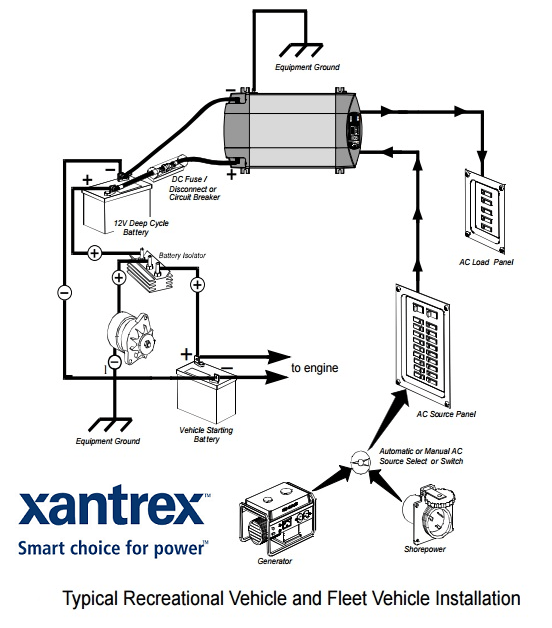
Xantrex mobile inverter installation diagram for a typical RV
Hit the Road Jack
This should be enough information to get you on your way to selecting solar panels for RV’s. We also covered how to size the battery bank, charge controller and inverter for an RV. Please email us, call us at 877-878-4060, or visit our website for help designing your RV solar system.

I love taking my RV out to the desert when I go riding. I love the quiet of the desert at night. Oh, and the stars out in the high desert are amazing at night. I do however get annoyed by my generator. I like having lights and power. I just do not like the noise. I never thought about how some solar panels could really help me enjoy nature with a little less noise.